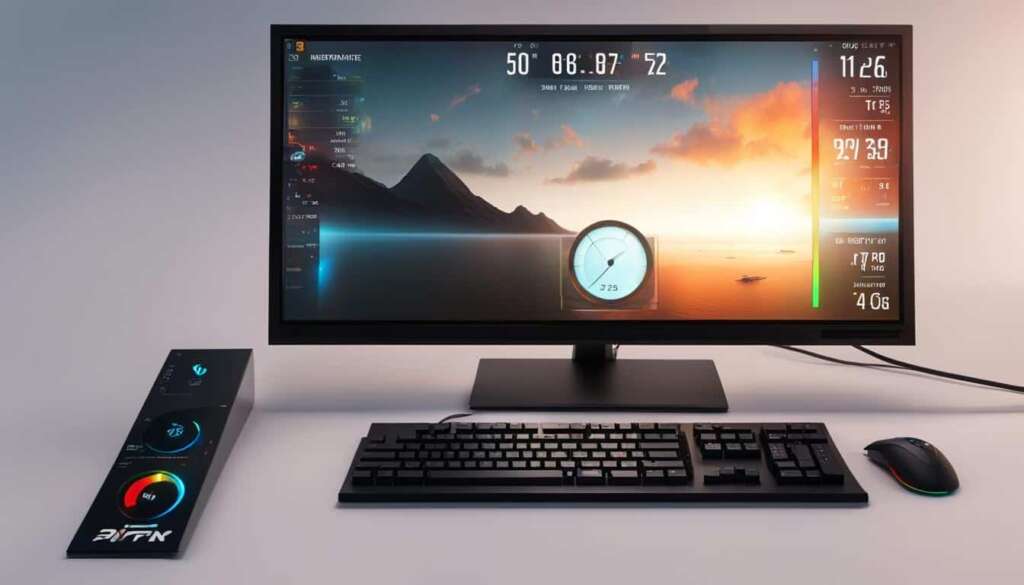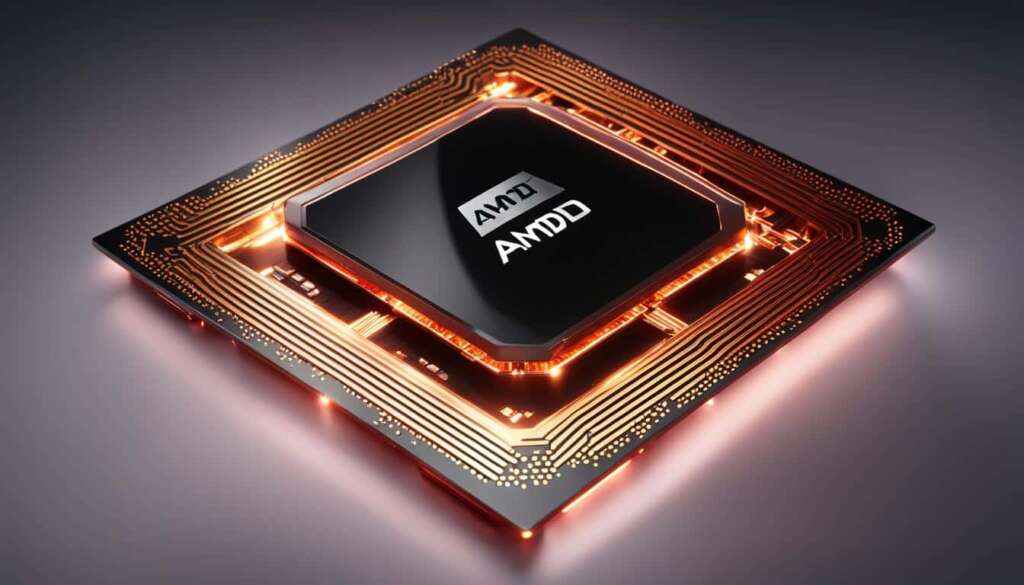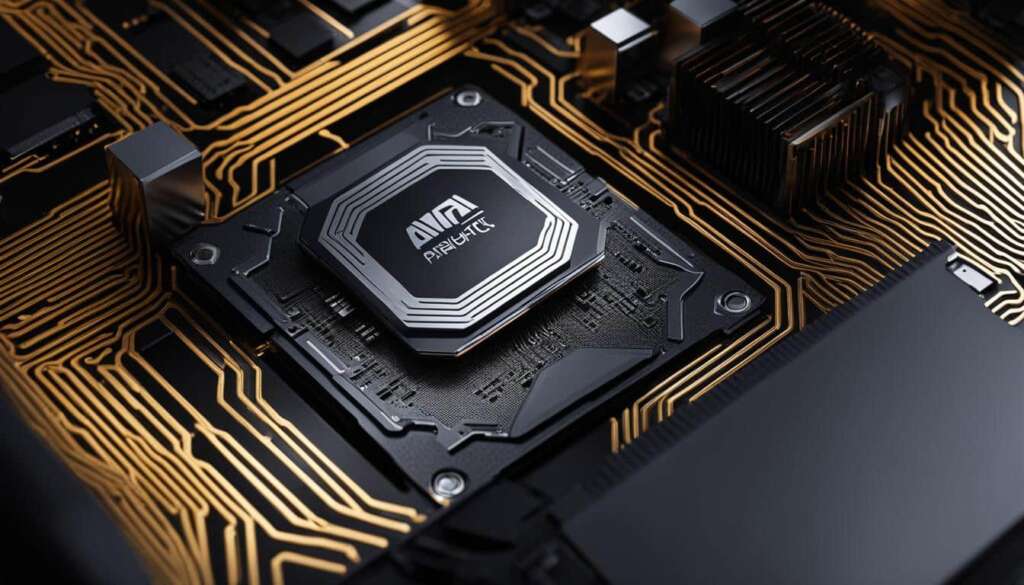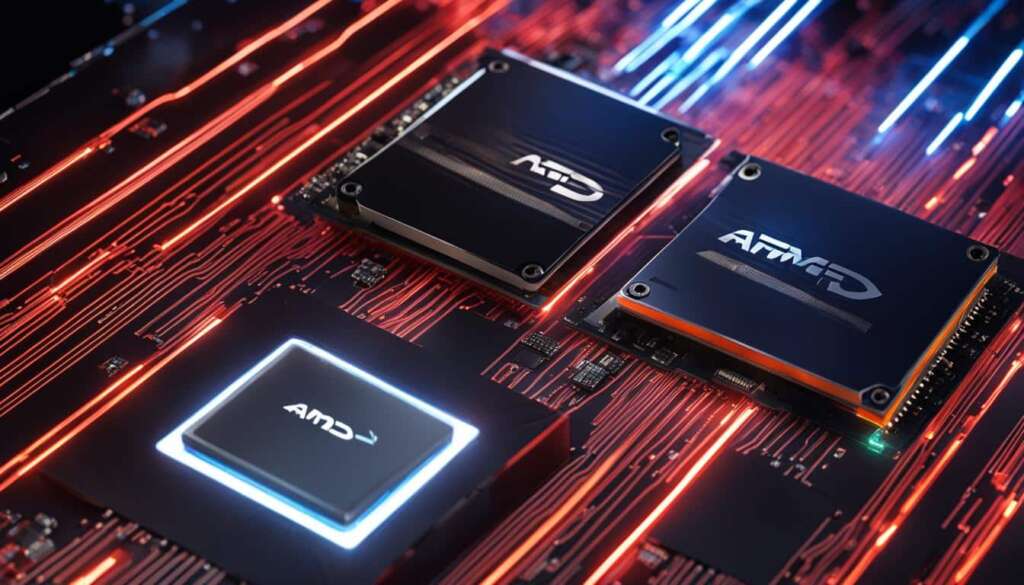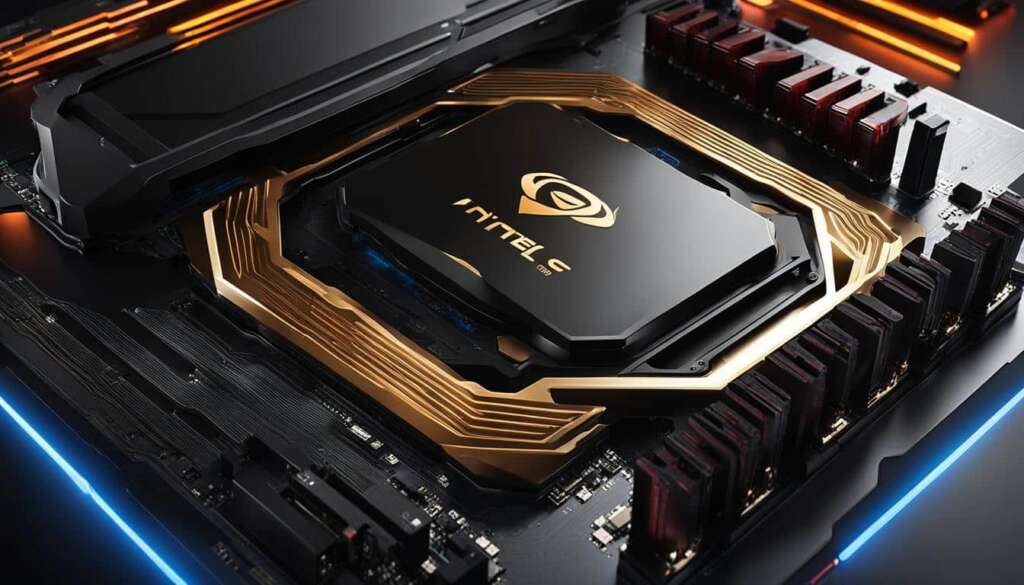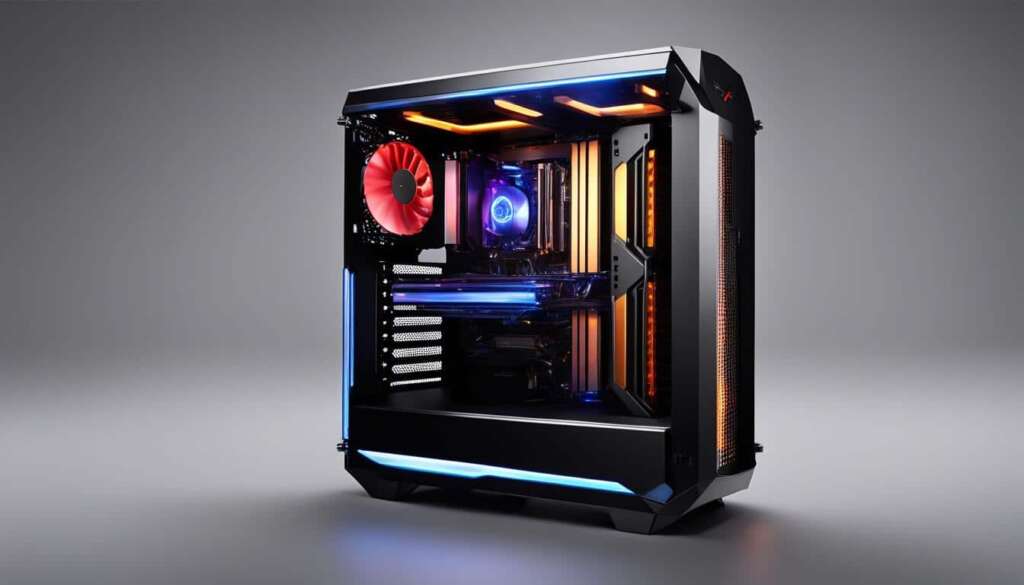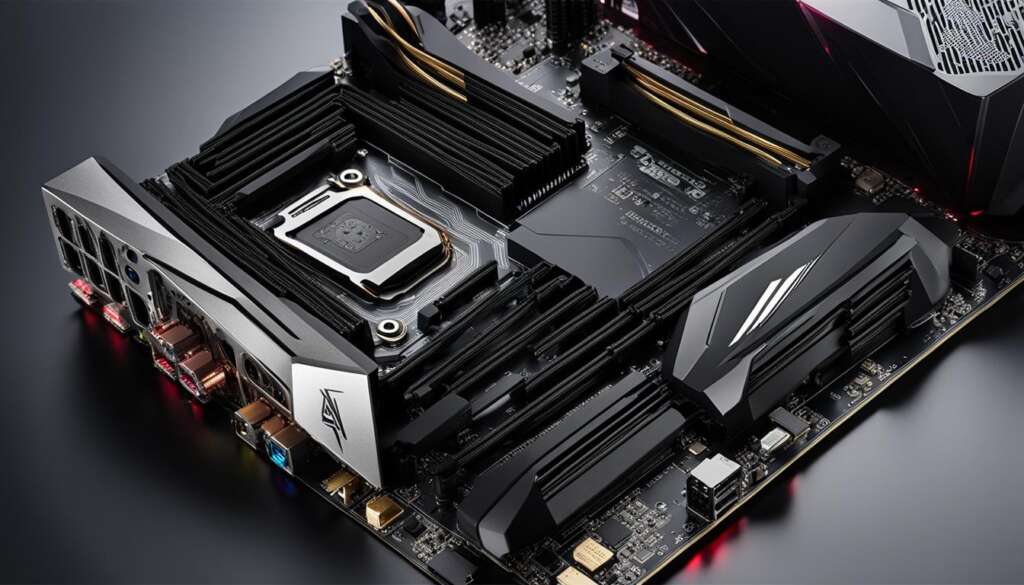Table of Contents
When it comes to gaming PCs, maintaining the optimal CPU temperature is essential for peak performance and the longevity of your gaming rig. In this article, we will explore the normal CPU temperature while gaming and provide insights on how to ensure your system stays cool under intense gaming loads.
Did you know that the maximum safe operating temperature for AMD Ryzen 7000X3D CPUs is around 89°C under intense multi-thread loads? For the multi-core models, the safe temperature is slightly higher, at 95°C. Staying within these temperature ranges is vital for achieving optimal performance and ensuring the reliability of your CPU.
Key Takeaways:
- Maintaining a normal CPU temperature is crucial for peak gaming performance.
- AMD Ryzen 7000X3D CPUs have specific temperature limits for safe operation.
- Operating within the recommended temperature range ensures the longevity of your gaming rig.
- Proper cooling solutions can help regulate the CPU temperature.
- Monitoring the CPU temperature allows you to identify potential performance issues.
Understanding the Ryzen 7000X3D CPUs
The AMD Ryzen 7000X3D CPUs introduce groundbreaking 3D V-Cache technology, revolutionizing gaming performance. With the ability to stack additional memory directly on the processor, these CPUs deliver unparalleled speed and responsiveness, particularly in applications that rely on larger cache memory like gaming.
One standout model, the Ryzen 7 7800X3D, offers gaming performance on par with the flagship Ryzen 9 7950X3D. Its cutting-edge architecture combined with the 3D V-Cache technology ensures a seamless gaming experience that surpasses the Intel i9-13900K in gaming performance.
This innovative cache technology enhances the Ryzen 7000X3D CPUs’ ability to process and retrieve data, reducing latency and maximizing efficiency. Gamers will appreciate the significant improvement in load times, frame rates, and overall system responsiveness, taking their gaming experience to new heights.
“The 3D V-Cache technology integrated into the AMD Ryzen 7000X3D CPUs is a game-changer for gamers who demand exceptional gaming performance and responsiveness. The Ryzen 7 7800X3D delivers outstanding results, rivaling even higher-end processors in the market.”
Furthermore, the Ryzen 7000X3D CPUs boast impressive multi-thread performance, making them ideal for content creators and professionals who require substantial processing power for demanding tasks such as video editing and 3D rendering. This versatility combined with the remarkable gaming performance solidifies the Ryzen 7000X3D CPUs as a top choice for enthusiasts and professionals alike.
Next, we’ll explore the influence of thermal design power (TDP) on CPU heat and how it can impact gaming performance.
Thermal Design Power (TDP) and CPU Heat
Thermal Design Power (TDP) is a crucial factor in understanding the maximum power consumption and heat dissipation of a CPU. While CPUs can generate significant heat during heavy usage, it is essential to ensure that the temperatures remain within the recommended range to prevent CPU overheating and potential damage.
For most desktop CPUs, maintaining temperatures below 80°C is considered ideal for optimal performance and longevity. When temperatures exceed 90°C, the CPU may begin throttling to protect itself, potentially affecting gaming performance and overall system stability.
To regulate CPU temperature and prevent overheating, adequate cooling solutions are necessary. The choice of cooling method can vary depending on individual preferences and requirements. Some popular options include:
- Air-cooling: Utilizing fans and CPU heatsinks to dissipate heat efficiently.
- Liquid-cooling: Employing liquid coolant and a series of tubes and radiators to transfer heat away from the CPU.
Below is a comparison of air-cooling and liquid-cooling:
| Cooling Method | Advantages | Disadvantages |
|---|---|---|
| Air-cooling |
|
|
| Liquid-cooling |
|
|
Ultimately, the choice between air-cooling and liquid-cooling depends on factors such as budget, performance requirements, and personal preferences. Additionally, it is essential to apply high-quality thermal paste between the CPU and the cooler to ensure optimal heat transfer.
Regular cleaning of fans and heatsinks is also crucial to prevent dust buildup, which can impede cooling performance and contribute to CPU heat accumulation. By maintaining appropriate cooling solutions and monitoring CPU temperature, users can mitigate the risk of CPU overheating and safeguard their system’s performance and longevity.
Effects of Overclocking on CPU Temperature
Overclocking is a popular practice among gamers and PC enthusiasts to push their CPU beyond its default settings for increased performance. However, it is important to understand the effects of overclocking on CPU temperature to prevent overheating and potential hardware failure.
When overclocking a CPU, the increased clock speed generates more heat, resulting in a higher CPU temperature. This heat is a byproduct of the increased power consumption and voltage required to achieve the higher clock speeds. As a result, the CPU temperature can increase significantly under overclocked conditions.
While moderate overclocking within safe voltage limits is unlikely to damage the CPU, pushing voltages too high can lead to overheating and potential CPU failure. It is crucial to strike a balance between performance gains and maintaining a stable temperature for optimal longevity and reliability.
To prevent overheating when overclocking, it is recommended to keep CPU temperatures below 80°C. This ensures that the CPU operates within a safe temperature range and avoids thermal throttling or permanent damage. Adequate cooling solutions, such as high-performance air coolers or liquid cooling systems, are essential to dissipate the increased heat efficiently.
Monitoring the CPU temperature during overclocking is also crucial to ensure that it stays within safe limits. This can be done using software utilities that provide real-time temperature readings, allowing users to keep track of the temperature and make necessary adjustments to prevent overheating.
Quote: “Overclocking can offer significant performance gains, but it comes with the risk of increased CPU temperatures. It is important to approach overclocking responsibly and prioritize proper cooling solutions to maintain a stable temperature.” – Hardware Expert
By understanding the effects of overclocking on CPU temperature and implementing appropriate cooling measures, users can safely optimize their CPU’s performance without jeopardizing its longevity and reliability.
| Effects of Overclocking on CPU Temperature | |
|---|---|
| Increased clock speed | Generates more heat |
| Higher power consumption and voltage | Leads to higher CPU temperature |
| Moderate overclocking within safe limits | Unlikely to damage the CPU |
| Higher voltages | Potential for overheating and CPU failure |
| Recommended CPU temperature during overclocking | Below 80°C for safe operation |
| Adequate cooling solutions | Essential to dissipate heat efficiently |
The Importance of Cooling Solutions for Overclocking
Cooling solutions play a vital role in managing CPU temperature during overclocking. Upgrading from the stock CPU cooler to high-performance air coolers or liquid cooling solutions can provide better heat dissipation and maintain a stable temperature. Additionally, users should ensure proper airflow within their PC cases by positioning fans strategically and removing any obstructions that might impede the heat dissipation process.
Fresh and high-quality thermal paste application between the CPU and cooler is another critical aspect to consider. Over time, thermal paste can degrade, leading to poor heat transfer and higher CPU temperatures. Applying fresh thermal paste helps maintain efficient heat transfer, resulting in lower temperatures during overclocking.
Overall, a combination of robust cooling solutions, proper airflow, and adequate thermal paste application is essential for managing CPU temperatures effectively while overclocking.
Controlling CPU Temperature for Optimal Performance
Adequate cooling solutions play a crucial role in maintaining optimal CPU temperature and preventing overheating. Whether you opt for air-cooling or liquid-cooling, these cooling methods can effectively regulate temperature and ensure your CPU operates within safe limits. Upgrading from the stock heatsink/fan that comes with your CPU can provide better cooling performance, especially when overclocking the processor for enhanced gaming experiences.
In addition to utilizing cooling solutions, another key factor in controlling CPU temperature is the application of thermal paste. By applying fresh thermal paste, you can improve the heat transfer between your CPU and cooler, enhancing overall cooling efficiency.
It’s also important to regularly clean your fans and heatsinks to prevent dust buildup. Dust accumulation can impede cooling performance and lead to higher CPU temperatures. By keeping these components clean and free of debris, you can optimize the airflow and ensure maximum cooling efficiency.
Benefits of Upgrading Cooling Solutions
Upgrading cooling solutions for your CPU can provide several benefits, including:
- Better heat dissipation and temperature regulation
- Reduced risk of thermal throttling
- Enhanced stability during intensive tasks
- Improved longevity of your CPU
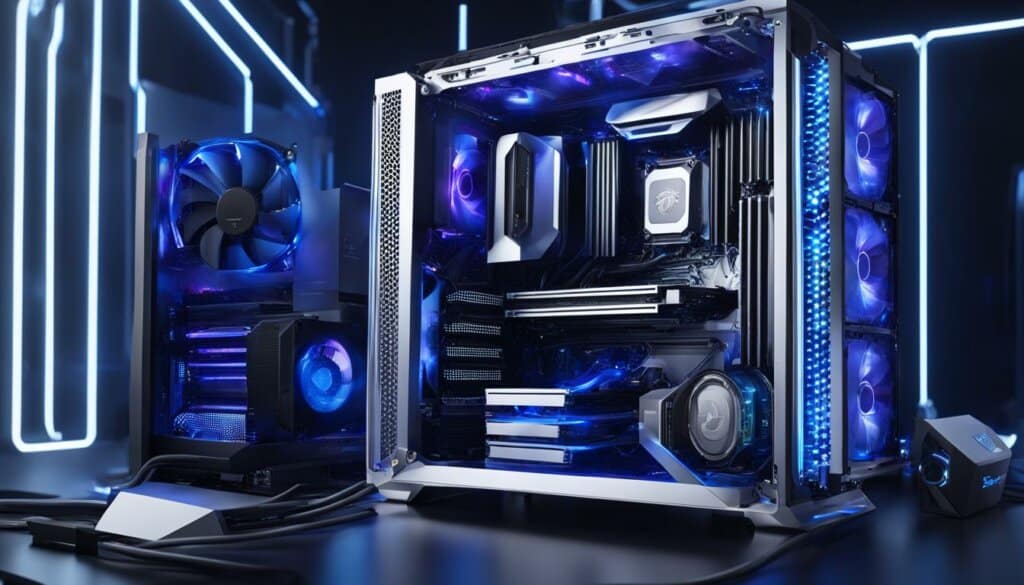
Investing in high-quality cooling solutions, such as advanced air coolers or liquid cooling systems, can significantly improve the overall performance and lifespan of your CPU. These solutions are designed to efficiently dissipate heat and maintain optimal temperatures, even during demanding gaming sessions or other resource-intensive tasks.
In summary, controlling CPU temperature is essential for achieving optimal performance and maximizing the longevity of your gaming rig. By utilizing effective cooling solutions, applying fresh thermal paste, and maintaining clean fans and heatsinks, you can ensure your CPU remains at ideal temperatures and perform at its best.
Importance of Monitoring CPU Temperature
Monitoring CPU temperature is crucial for identifying potential overheating issues. With the advancements in technology, there are now software tools available that provide real-time temperature readings, allowing users to keep track of their CPU temperature during gaming or other intensive tasks.
One such monitoring software is HWMonitor. This tool offers comprehensive monitoring capabilities, allowing users to monitor not only their CPU temperature but also other vital system components such as GPU temperature, fan speeds, and voltages. HWMonitor provides accurate and up-to-date information, ensuring that users stay informed about their system’s performance.
Another popular monitoring software is HWiNFO 64. This software provides detailed information about hardware components, including CPU temperature. It offers a user-friendly interface and real-time monitoring capabilities, making it an excellent choice for gamers and PC enthusiasts.
By utilizing monitoring software like HWMonitor or HWiNFO 64, users can keep a close eye on their CPU temperature and take proactive measures if temperatures exceed safe ranges. High CPU temperatures can indicate a cooling problem that needs to be addressed, such as insufficient airflow or a malfunctioning cooling system.
“Monitoring CPU temperature is like having a thermometer for your gaming rig. It allows you to diagnose potential issues before they cause permanent damage to your hardware.” – PC Gaming Enthusiast
Regularly monitoring CPU temperature not only helps prevent overheating but also ensures optimal performance. Excessive heat can lead to thermal throttling, where the CPU reduces its performance to prevent damage. This can result in decreased overall gaming performance and a less enjoyable gaming experience.
Here’s an example of how HWMonitor displays CPU temperature:
| Component | Temperature |
|---|---|
| CPU | 75°C |
By regularly monitoring CPU temperature with reliable software tools like HWMonitor or HWiNFO 64, gamers can ensure that their system operates within safe temperature ranges, optimizing performance, and prolonging the lifespan of their CPU.
Conclusion
Maintaining an optimal CPU temperature is crucial for enhancing gaming performance and ensuring the longevity of your gaming rig. By following recommended temperature ranges and implementing proper cooling solutions, you can prevent overheating and potential damage to your CPU. This will enable you to make the most of your gaming experience while safeguarding the integrity of your hardware.
By keeping your CPU temperature within safe limits, you can unlock the full potential of your gaming system. High temperatures can lead to thermal throttling, diminishing your CPU’s performance and causing gameplay interruptions. It is essential to prioritize temperature management to enjoy a smoother gaming experience and maximize your gaming rig’s capabilities.
Regularly monitoring your CPU temperature is vital in identifying potential overheating issues. Utilize dedicated monitoring software such as HWMonitor and HWiNFO 64 to keep track of real-time temperature readings. If you consistently observe temperatures exceeding the recommended ranges, it may indicate a cooling problem that requires attention. Prompt action can help prevent long-term damage and maintain exceptional performance.
In conclusion, by maintaining an optimal CPU temperature, you can achieve peak gaming performance and extend the longevity of your CPU. Implementing effective cooling solutions and regularly monitoring your CPU temperature will safeguard your hardware investment, ensuring an outstanding gaming experience for years to come.
FAQ
What is the optimal CPU temperature for gaming PCs?
The optimal CPU temperature for gaming PCs is below 80°C. It is important to keep temperatures within this range to achieve peak performance and ensure the longevity of your gaming rig.
What are the key features of the AMD Ryzen 7000X3D CPUs?
The AMD Ryzen 7000X3D CPUs feature 3D V-Cache technology, which allows for additional memory to be stacked on the processor. This technology provides a performance boost, particularly in applications that benefit from larger cache memory like gaming. The Ryzen 7 7800X3D, in particular, offers gaming performance on par with the flagship Ryzen 9 7950X3D and outperforms the Intel i9-13900K in gaming performance.
What is TDP and why is it important for CPU heat?
TDP, or Thermal Design Power, is a measure of the maximum power consumption and heat dissipation of a CPU. It is important to consider TDP when managing CPU heat as excessive heat can lead to overheating and potential damage to the CPU.
How does overclocking affect CPU temperature?
Overclocking can significantly increase CPU temperature. While overclocking within safe voltage limits is unlikely to damage the CPU, pushing voltages too high increases the risk of overheating and potential CPU failure. It is recommended to keep CPU temperatures below 80°C when overclocking and to ensure proper cooling solutions are in place.
What cooling solutions can help control CPU temperature?
Adequate cooling solutions, such as air-cooling or liquid-cooling, can help regulate CPU temperature and prevent overheating. Upgrading from the stock heatsink/fan that comes with the CPU can provide better cooling performance, especially when overclocking. Additionally, applying fresh thermal paste can improve heat transfer between the CPU and the cooler. Regular cleaning of fans and heatsinks also prevents dust buildup, which can impede cooling performance.
How can I monitor CPU temperature?
Monitoring software tools like HWMonitor and HWiNFO 64 can provide real-time temperature readings, allowing you to keep track of your CPU temperature during gaming or other intensive tasks. Monitoring CPU temperature is crucial for identifying potential overheating issues and taking prompt action to address cooling problems.
Why is it important to maintain a normal CPU temperature while gaming?
Maintaining a normal CPU temperature while gaming is vital for achieving peak performance and ensuring the longevity of your gaming rig. By following recommended temperature ranges, using proper cooling solutions, and monitoring CPU temperature, you can prevent overheating and potential damage to the CPU, optimizing your system’s performance and enjoying a smoother gaming experience.

